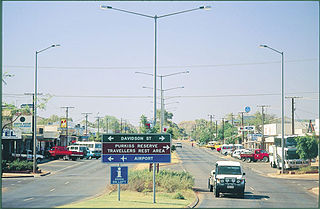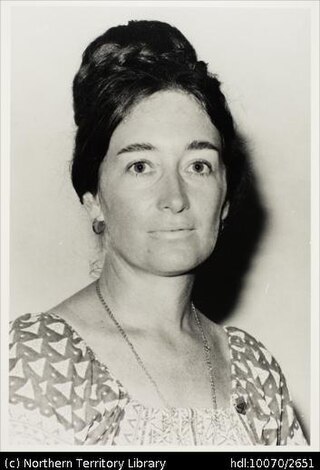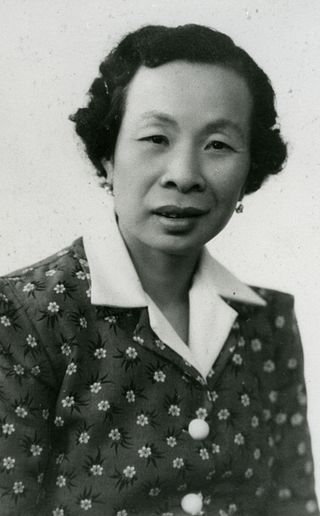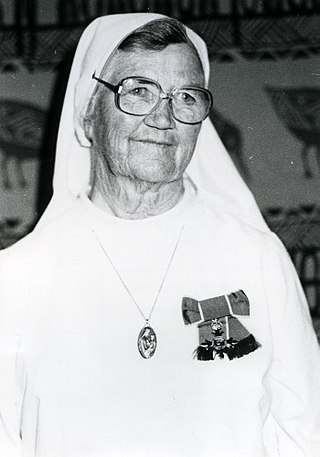
Tennant Creek is a town located in the Northern Territory of Australia. It is the seventh largest town in the Northern Territory, and is located on the Stuart Highway, just south of the intersection with the western terminus of the Barkly Highway. At the 2021 census, Tennant Creek had a population of 3,080 people, of which 55% (1,707) identified themselves as Indigenous.

Pine Creek is a small town in the Katherine region of the Northern Territory, Australia and is situated just off the Stuart Highway; it is 90kms north of Katherine. As at the 2021 Census there were 318 residents of Pine Creek, which is the fourth largest town between Darwin and Alice Springs.

Lake Mary Ann or Tingkkarli, previously known as Mary Ann Dam is situated about 5 kilometres (3.1 mi) north of Tennant Creek, Northern Territory, Australia, just off the Stuart Highway. It is a man-made dam where some water sports can be conducted such as swimming or canoeing, surrounded by landscaped grassy areas on one side and natural bushland on the other.

The Victoria Hotel, or The Vic as it is commonly known, is a heritage listed pub located in Darwin, Northern Territory, Australia. Built in 1890, it is an important historical building but is currently closed.
The Moonta Herald and Northern Territory Gazette was a newspaper produced on the vessel SS Moonta that was sailed by George Goyder in 1868 and 1869 from Port Adelaide to Darwin. The aim of the 41-day voyage was to provide an initial survey of what was to become the Northern Territory.

Alline Dawn Lawrie is an Australian former politician. She was the independent member for Nightcliff in the Northern Territory Legislative Assembly from 1974 to 1983; in the First Assembly, she and fellow independent Ron Withnall were the sole non-Country Liberal Party members.

The Finniss River is a river south of Darwin, running west from the flank of Mount Minza, passing north of Litchfield National Park and flowing into the sea at Fog Bay. The East Branch of the Finniss was heavily polluted during the 1970s due to uranium mining at Rum Jungle mine about 105 km south of Darwin. The Finniss River Land Claim was presented to Judge John Toohey in 1981 but the former Rum Jungle mine site, contained within Area 4 of the Finniss River Land Claim (1981) was excluded from the grant to the Finniss River Land Trust due to the concerns of the Kungarakany and Warai peoples who are joint traditional Aboriginal owners of that area.

Lily Ah Toy was an Australian pioneer and businesswoman famous in the Northern Territory.

Burnett House is a historic building that forms part of the Myilly Point Precinct in Darwin, Northern Territory. It is the only remaining two storey house designed by architect Beni Burnett. It is managed by the National Trust of Australia.

Eileen Cummings is a teacher, policy and liaison officer and Indigenous leader in the Northern Territory of Australia. She is a member of the Rembarrnga Ngalakan ethnic groups. She is also a member of the 'Stolen Generation' and is an activist advocating for the well-being of living members of that group.

The Star Theatre was the first purpose-built cinema in Darwin in the Northern Territory of Australia. Destroyed during Cyclone Tracy, it was the centre of Darwin's social life between the 1930s and 1960s.
Lameroo Beach is a small beach located off the esplanade in central Darwin in the Northern Territory of Australia. It was the location of the town's historic baths between 1922 and 1974. The name for Lameroo Beach comes from a corrupted interpretation of the nearby Aboriginal site Damoe-Ra, which means "eye" or "spring" in Larrakia.

Lee Toy Kim better known as Granny Lum Loy or Lu Moo was a renowned Chinese businesswoman in Darwin in the Northern Territory of Australia.

Lillian Maud Dean was a photographer and local government politician in Darwin in the Northern Territory of Australia. She was the first woman to be elected to local council in the Northern Territory.

Sue Wah Chin was a Chinese entrepreneur living and working in Darwin in the Northern Territory of Australia. The Sue Wah Chin or 'Stonehouse' building, one of the remaining heritage buildings in central Darwin, is named after her.
Ruth Sabina Heathcock BEM was an award-winning remote area nurse in the Northern Territory of Australia who specialised in the treatment of leprosy. She received an Order of the British Empire for rowing 145 kilometres to save a man who accidentally shot himself.

Maranboy was a tin mine near Barunga, about 70 kilometres east of Katherine in the Northern Territory of Australia.

Olive May Pearce, also known as Sister Eucharia was an Australian nun best known for her work with Aboriginal children and leprosy patients. She was made a member the Order of the British Empire in 1981.

Mildirn, sometimes spelt Medlone, also known as Jack Davis, Old Jack Davis or Port Essington Jack was a well-known Aboriginal leader, translator and advisor for Port Essington, a site of early British settlement in the Northern Territory of Australia.

Ruby Gap Nature Park or Tyweltherreme is a protected area in the Northern Territory consisting of 9,257 hectares and access to it is through Arltunga Historical Reserve.



















